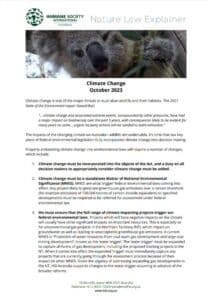One of the most important global meetings on wildlife trade has just wrapped up in Uzbekistan. It’s capital city Samarkand was where governments convened for the 20th Conference of the Parties (CoP20) to the Convention on International Trade in Endangered Species of Wild Fauna and Flora (CITES) to decide how international trade should be managed for some of the world’s most threatened...
Climate change is one of the major threats to Australian wildlife and their habitats. The 2021 State of the Environment report found that:
”… climate change and associated extreme events, compounded by other pressures, have had a major impact on biodiversity over the past 5 years, with consequences likely to be evident for many years to come… urgent recovery actions will be needed to avert extinction.”
The impacts of the changing climate on Australian wildlife are undeniable. It’s time that our key piece of federal environmental legislation fully incorporates climate change into decision making.
Properly embedding climate change into environmental laws will require a number of changes, which include:
- Climate change must be incorporated into the objects of the Act, and a duty on all decision makers to appropriately consider climate change must be added. See our Nature Law Explainer on Objects and Duties for more information.
- Climate change must be a standalone Matter of National Environmental Significance (MNES). MNES are what ‘trigger’ federal environmental laws coming into effect. Any project likely to generate greenhouse gas emissions over a certain threshold (for example emissions of 100,000 tonnes of carbon dioxide equivalent) or specified developments must be required to be referred for assessment under federal environmental law.
- We must ensure that the full range of climate impacting projects trigger our federal environmental laws. Projects which will have negative impacts on the climate will usually have other significant impacts on important resources. This is especially so for unconventional gas projects in the Northern Territory (NT), which impact on groundwater as well as leading to unacceptable greenhouse gas emissions. A current MNES is “Protection of water resources from coal seam gas development and large coal mining development”, known as the ‘water trigger’. The ‘water trigger’ must be expanded to capture all forms of gas development, including the proposed fracking projects in the NT. When it comes into effect the expanded ‘trigger’ must immediately capture any projects that are currently going through the assessment process because of their impact on other MNES. Given the urgency of addressing expanding gas developments in the NT, HSI Australia supports changes to the water trigger occurring in advance of the broader reforms.
- There must be legal requirements for the accurate disclosure and assessment of all lifecycle emissions from a project, including any emissions that occur as a later consequence of the project, such as the burning of coal extracted in Australia. This disclosure must be supported by a climate impact assessment for all projects. Consideration of climate impacts must use the best available science and climate-impact modelling.
- The definition of an ‘impact’ under the Act must be amended to fully capture cumulative impacts and those impacts that may not be located in the immediate vicinity of the project site but will cause negative impacts on wildlife and their habitat – such as climate change. When assessing a project, it should not be possible for decision makers to dismiss a project’s impacts because something else might also cause those impacts (for example assuming that if Australia doesn’t open a new coal mine, someone else will), and it must be clear what impacts will be considered unacceptable.
- There must be clear guidance for decision makers on how to properly consider climate impacts in deciding whether a project should be approved and whether to impose specific conditions on that approval. To do this, climate must be integrated into the proposed National Environmental Standards.
- Decision makers must be required to adhere to global and national emission reduction targets, such as those set out by the Climate Change Act 2022 as well as carbon budgets. A carbon budget allows you to identify how many more greenhouse gas emissions can be emitted before temperature will rise by certain amount. Australia must identify its fair share of a global carbon budget that will limit warming to no more than 1.5oC above pre-industrial levels and ensure that any new project approvals will not cause us to exceed that budget.
- Impacts on wildlife and their habitats as a result of climate change must be properly considered. This means that the listing of species and ecological communities for protection and planning for their recovery, must consider the impacts of climate change (both now and into the future). Climate refugia (those areas that will help species and communities persist in the face of worsening climate change) must be protected as critical habitat.
- Upfront regional planning must consider current and future climate impacts and set clear expectations around where ecologically sustainable development may be possible and which areas are off limits, including providing for the protection of climate refugia.
- Our new laws must also be able to facilitate the transition to renewable energy in a way that does not compromise on environmental standards or further contribute to the extinction crisis. Upfront planning and appropriate technological design will be vital. Read our blog on seabirds and wind farms for more information.
Our extinction crisis and climate crisis are intrinsically linked, and, done well, the current environmental law reform process provides an opportunity to set the framework to address both.
Download a PDF version of this blog, so you can print and share with your Member of Parliament

Learn more about what we need to achieve stronger laws for Australian nature. Read our other Nature Law Explainer blogs:
- Community Rights in Decision Making
- What are National Environmental Standards and why do we need them?
- The importance of an “EPA”
- Critical habitat needs protection
- Managing wildlife trade
- Objects and Duties
- Strengthening Conservation Planning
- Nature Laws Explainer: Protecting Marine and Migratory Species
- Regional Planning
- What are biodiversity offsets? (Part 1)
- What are biodiversity offsets (Part 2)
- What ‘triggers the EPBC act?
- Strong nature laws shouldn’t be undermined by exemptions
- Environmental assessments and decision-making


